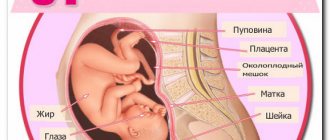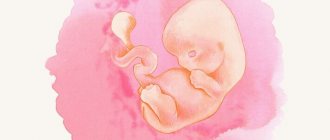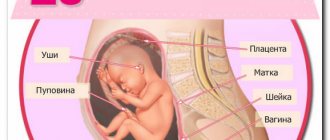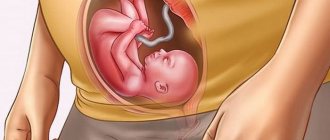In Russia, it is customary to conduct screening ultrasound examinations three times during pregnancy: at 10-14, 20-24 and 30-34 weeks of gestation. In addition, additional fetal ultrasounds are acceptable for medical reasons. An ultrasound examination of early stages (up to 8 weeks) is often prescribed to confirm the onset of intrauterine pregnancy and an ultrasound examination before childbirth to determine the tactics of obstetric care.
14 weeks is the optimal period for conducting perhaps the most important study during the entire pregnancy: the first perinatal screening. If by the 14th week the expectant mother has not yet undergone such screening, it is strongly recommended that this be done before the expiration of fourteen weeks from the first day of the last menstrual period.
First screening, 14 weeks of pregnancy
The fact is that after this period, the results of a biochemical blood test (this includes the first screening) will not be informative. And the increased size of the fetus in the womb after 14 weeks can make it difficult to assess the risk of developmental abnormalities! In addition, if serious pathologies are detected, the woman and doctors have little time to decide whether to prolong the pregnancy further.
Why and to whom is the study recommended?
Traditionally, an ultrasound is performed at 10-12 weeks, but at 14 weeks such a study can also be quite informative.
Why do it? Here are some reasons:
- You can assess the degree of development of the baby and determine how well his indicators correspond to the norms. At this stage, the fetus is already well formed and this allows you to clearly visualize its structure.
- Determine the baby’s height (coccygeal-parietal size), the size of the head (biparietal size), its circumference and the circumference of the tummy.
- Now the length of the thigh is clearly visible, so it is possible to compare the sizes of both thighs and determine whether there is a developmental defect.
- You can evaluate the development of the bones of the radius, humerus, elbows, tibia, bones of the feet and hands.
- It is possible to evaluate the work and condition of the heart, stomach, brain, kidneys, intestines and bladder.
- Ultrasound monitoring is needed to perform amniocentesis, that is, to study the karyotype of the fetus.
Preparing for the examination: what to expect and how to prepare
Some women are nervous before undergoing routine ultrasound examinations. This should not be done - they are safe for mother and baby. If the patient is still worried, you can listen to calm music while getting ready for the ultrasound. Scientists have not found a detrimental effect of the procedure on the development of the human embryo. So it is better to discard doubts and prejudices.
Specialized training is not required if the first screening ultrasound is planned. But if a woman comes with a full stomach or bladder, she will not be too comfortable. A sensor pressing on your stomach can cause an unpleasant feeling. Therefore, the main thing is to empty your bladder first and not to overeat before the examination. However, sometimes doctors may ask you to fill your bladder. This is necessary if the placenta is low. To make the task easier, you should take a small bottle of water for the procedure. You will also need:
- a towel for covering the couch or a specialized disposable diaper;
- replacement slippers or shoe covers (in some clinics they are issued on the spot);
- for transvaginal examination - a medical condom;
- a pair of sterile gloves;
- a pack of wet wipes (they are used to wipe the stomach from the gel).
But this list is more appropriate for those surveyed who use the services of state antenatal clinics. Patients of private clinics do not have to take anything with them at all, because the kit necessary for ultrasound is already included in the total cost of care.
Condition of mother and fetus
The 1st trimester has ended, the manifestations of toxicosis have become less noticeable, and if the baby is developing correctly, then the mother feels as good as she can feel during pregnancy.
Among the unpleasant sensations during this period, it is worth noting headaches and abdominal pain: abdominal pain is caused by stretching of the ligaments that hold the uterus, headaches are similar to migraines.
The mother’s weight gain is due to more active blood circulation, but her appetite is already increasing.
Unpleasant physiological changes are possible: brittle hair, bleeding gums, lethargy and weak immunity are caused by a lack of vitamins.
In addition, the load on the mother’s kidneys increases (the fetus’s urinary system has begun to function), the blood sugar level in a mother with diabetes may decrease, and mood swings are observed (the fetus’s pancreas and thyroid gland are already functioning).
The baby himself already looks like a little man (the size of an apple), he begins to move and hears his mother (his vision also works perfectly). All his organs work, but they are closely connected with the mother’s body. The most important processes now occur in his brain and internal organs.
During this period, the face is formed, the bone marrow begins to produce blood cells, the prostate develops in boys, and ovarian prolapse occurs in girls. The baby yawns, sucks his thumb and grimaces.
Reference! Both mother and fetus need more protein and calcium than ever before for full development. Feed yourself and him with fermented milk products.
What happens in the body of the expectant mother?
- During this period, the expectant mother may develop brown pigment spots and pimples on her skin. This phenomenon is also called chloazama or “mask of pregnancy”, and most often pigment spots appear in the cheeks, nose or around the eyes. You may also notice a dark line on your body that extends from your navel down. Don’t worry, pigmentation will definitely disappear after childbirth, because the same pregnancy hormones are to blame. In the meantime, try to use natural and hypoallergenic cosmetics that do not contain artificial ingredients. Pay attention to special cosmetics from the “For Expectant Mothers” series. It is the safest and most gentle for you. Also, try not to be in the open sun, as pigmentation may increase.
- Your nipples have become rougher and your breasts continue to grow. But she is no longer as sensitive and painful as in the first trimester.
- The uterus rises slightly, which means its pressure on the bladder decreases (frequent urination is left behind for now; it will return in the third trimester).
What does ultrasound diagnostics show?
In the 1st trimester, changes in the baby’s body occurred regularly and almost every day. Now there are much fewer changes and all the fetal forces are directed towards the development of the body and brain activity.
On an ultrasound at 14 weeks you can see:
- First of all, the activity of the fetus is striking;
- it is already well established in the uterus (it is slightly larger in size than a grapefruit);
- his joints have developed, so his movements have become clearer and more coordinated;
- the baby bends his arms and legs;
- no longer drops the head onto the chest (the neck muscles have developed, and the neck itself has lengthened);
- hiccups, sucks a finger and responds to touch (a “grasping” reaction appears);
- tumbles, swims and grabs the umbilical cord;
- During this same period, the child’s facial expressions develop: he learns to control his facial muscles.
In addition, at 14 weeks the baby’s face already takes on a resemblance to his mother or father. Hairs appear on the head and body, and emerging eyebrows and eyelashes can be seen on the face.
Complications
If you are 14 weeks pregnant, you can breathe easy, as the risk of miscarriage at this stage is significantly reduced. However, the development of other, no less serious complications, including frozen pregnancy, cannot be ruled out.
Frozen pregnancy
This is a pathology in which the fetus stops developing at a certain time and dies. This pathology can appear at any time from the first to 28 weeks. But most often, frozen pregnancy is diagnosed in the first and early second trimester up to fourteen weeks.
Advice! The arrest of fetal development occurs asymptomatically, so it is possible to detect this pathology in a timely manner only if you regularly visit the doctor and timely undergo all the necessary examinations.
Signs that should alert an expectant mother:
- bloody issues;
- pulling sensations in the stomach;
- chills, fever.
However, a diagnosis can only be made after a series of examinations - tests and ultrasound. At present, it is not always possible to understand what exactly caused the cessation of fetal development. This situation may happen:
- when the mother is infected (rubella, herpes and other viruses);
- in the presence of a genetic malfunction in the fetus;
- with hormonal disorders;
- with the wrong lifestyle of the mother.
Pain
Ideally, at this stage the pregnant woman should not have pain or other discomfort. But this doesn't always happen. Let's figure out what happens in the 14th week of pregnancy. During this period you may be concerned about:
- Back pain associated with increasing load on the spine. By this period of pregnancy, you should stop wearing high-heeled shoes, as such shoes create even more stress.
- Migraine-like headaches. To avoid their occurrence, it is necessary to establish a normal routine and get more rest and be in the fresh air. To relieve pain, you should not take painkillers without a doctor's recommendation. Try a head massage.
- My stomach hurts and feels tight. If the pain is nagging and short-lived, then you shouldn’t worry too much. Unpleasant sensations are caused by stretching of the ligaments that support the uterus and abdominal muscles. If a woman notices that she has a strong pull in her lower abdomen, and the pain is accompanied by brown or bloody discharge, then this is a sign of uterine hypertonicity. This condition requires treatment, possibly in a hospital. The consequences of hypertonicity can be extremely sad, so if you have pain in the lower abdomen, you should definitely contact a gynecologist, and if signs of bleeding appear, you should call an ambulance.
It is possible that during this period of pregnancy some chronic diseases will worsen. So, pain in the upper abdomen, vomiting, heartburn can be signs of exacerbation of gastritis. And cutting pain in the back or lower abdomen against the background of frequent and painful urination indicates an inflammatory process in the genitourinary system. This may result in exacerbations of cystitis or pyelonephritis.
Discharge
Normally, discharge at the 14th week of pregnancy is moderate, light, and does not cause discomfort. If the color of the discharge changes (from transparent or milky white to yellow, gray or greenish) and itching and burning occurs, you should definitely visit a gynecologist. Such changes indicate the presence of infection or exacerbation of thrush.
Diseases must be treated. Moreover, treatment must be prescribed by a doctor; self-medication is prohibited!
Colds
Few people manage to never “catch” ARVI throughout their entire pregnancy. A cold at 14 weeks is no longer as dangerous for the unborn baby as illnesses at earlier stages. However, any illness of the expectant mother can become a catalyst for the development of pregnancy complications.
Colds that occur with an increase in temperature are especially dangerous. Do not under any circumstances try to transfer the disease on your legs. Consult a doctor and complete the prescribed course of treatment.
What can be seen in the photo of the fetus?
If the examination was informative, you will notice that in the photo the fetus already looks like a small and fully formed person.
For the first time, it is possible to see the baby’s face in a photo at 14 weeks and even notice the resemblance to the parents. The child’s body is already quite proportional, and if the photo is of high quality, you will be able to see the baby’s arms, legs, and fingers, and perhaps you will notice the expression on his face.
How does a baby develop at 14 weeks of pregnancy?
The approximate growth of the unborn child in the uterus by this time is from 8 to 11 cm, and its weight is approximately 40 grams. To some, such dimensions may seem insignificant, but, in reality, at 14 weeks, almost all organs of the fetus are formed! In the future, only their growth, development and complication of functions will occur. This means that at a period of 12-14 weeks, the doctor will be able to accurately diagnose malformations of the child in the womb, clarify the individual structural features and make a diagnosis.
By the time of the study, the first trimester, which is considered the most critical time of pregnancy, had already been completed. For a woman, this brings good news: the period of toxicosis is over or will end soon; The second trimester of pregnancy is usually associated with improved well-being, emotional uplift and the onset of the long-awaited maternity leave! But at the same time, it is necessary to find out whether the important stage of the formation of all organ systems of the unborn child has been completed correctly. Therefore, up to 14 weeks is the time for the expectant mother to find out how her pregnancy is developing.
Normal indicators
Measurements at week 14 are quite easy to take. The following figures indicate that the fetus is developing correctly:
- Fetal growth. It is also known as the coccygeal-parietal size or KTR. It is measured only from the tailbone to the crown, the length of the legs is not taken into account here. If at 12-13 weeks of pregnancy it was possible to accurately determine the timing of pregnancy using this parameter, now this is no longer possible and prenatal screening will be unreliable. With normal development, the fetal size should be 76 mm.
- Biparietal size, also known as BPR. We are talking about the transverse size of the fetal head. Now this figure is the main one in determining the timing of pregnancy. In addition, this figure may indicate normal brain development. The normal BDP during this period will be 27 mm.
- Abdominal circumference, also known as fetal coolant. The normal figure now would be 78 mm.
- Head circumference, also known as fetal OG. Another necessary indicator when diagnosing the timing of pregnancy. The normal figure here would be 97 mm.
- Thigh length, also known as DB. When performing an ultrasound, it is necessary to measure both femurs to exclude malformations. The norm will be 12.5 mm for each hip.
- It is also necessary, if possible, to measure the tibia, humerus, radius bones, the length of the feet and hands.
Nutrition
Continue to lead a healthy lifestyle and eat right. Include kiwi, seafood, seaweed, and persimmon in your menu. Also, eat foods enriched with calcium - meat, eggs, milk, hard cheese, cottage cheese and fermented milk products.
During these stages of pregnancy, try to have foods containing iodine and calcium on your table, since the baby’s skeletal system and thyroid gland are now actively developing.
Drinks for a pregnant woman - how much and what to drink in the heat?











